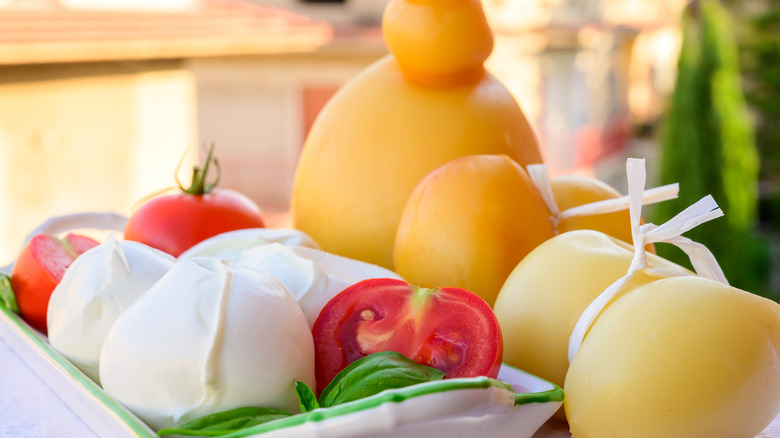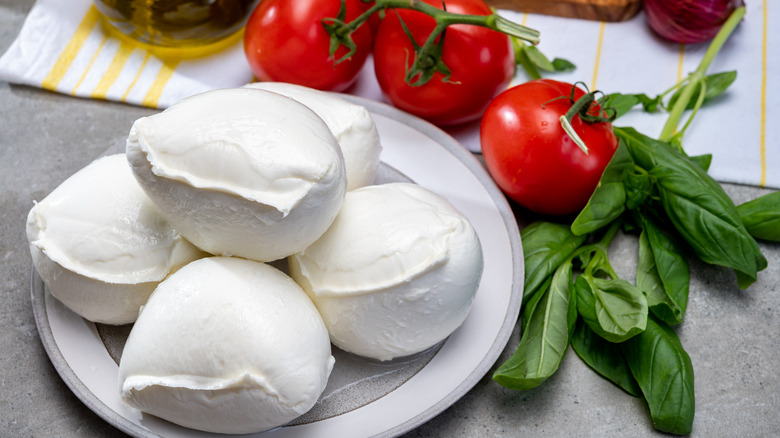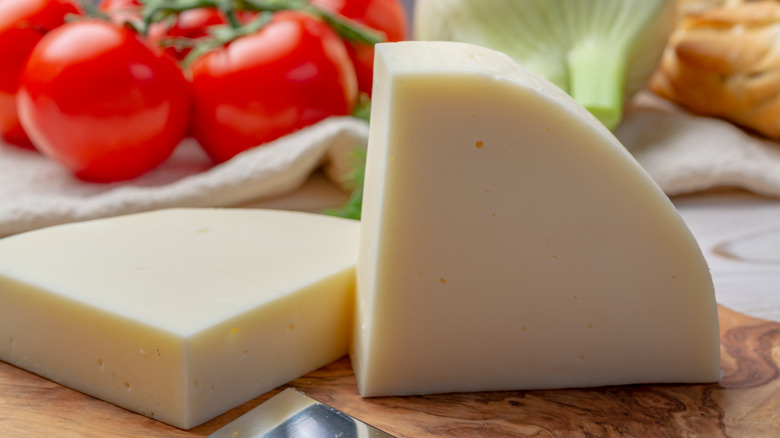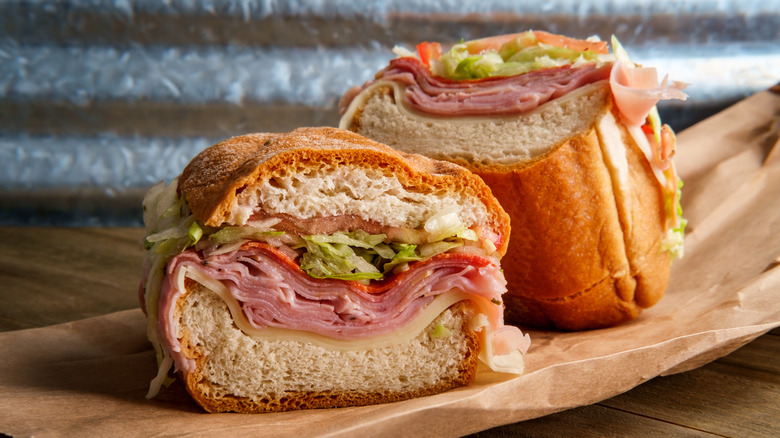Provolone Vs. Mozzarella: What's The Difference?
Italian cheeses are numerous, plentiful, and delicious, from soft, sweeter cheeses like ricotta and mascarpone to hard, sharp cheeses like asiago, pecorino, or Parmigiano-Reggiano. It's a spectrum of total deliciousness. Of all the wondrous types of Italian cheeses, there are two types in particular that Americans encounter pretty often — provolone and mozzarella. While these cheeses might seem quite different at first glance (since mozzarella is a semi-soft cheese and provolone is a semi-hard cheese), the two are sometimes confused and worthy of a side-by-side comparison.
Though the two look quite different once they hit dairy-aisle shelves, these two kinds of cheese are actually cousins. This may seem counter-intuitive since their textures are quite dissimilar, but the way in which they are related has to do with how they are made. In cheesemaking, there are several different production processes, and the one that unites mozzarella and provolone is one that is called hand-spinning, or "pasta filata" in Italian.
Mozzarella
Traditional mozzarella comes from southern Italy and is made using either the milk of cows or water buffalo, known as fiori di latte or mozzarella di bufala, respectively. As mentioned, mozzarella is a hand-spun cheese, and during this process, the curds and whey of the milk are separated from one another. In some cases, calf's rennet is added to the milk to help the curds separate, and once they are separated the curds are gently heated until they melt and can be molded by hand. In this step of the process, the mozzarella becomes extremely stretchy and stringy and takes on its signature texture. Cheesemakers then hand-knead the curds into the soft balls you see when you buy or are served fresh mozzarella. These delicate cheese balls are set in a brine water bath to cure but should be enjoyed sooner than later. Due to their delicate texture and high water content, mozzarella cheese is never aged and best consumed fresh within 5 days of opening.
Provolone
Provolone, another cheese originating from southern Italy, is made from cow's milk and is semi-hard. Unlike mozzarella, it undergoes an aging process. What Americans think of as provolone is probably more closely related to Italian provola cheese, which is a very mild, semi-hard cheese. The provolone that's made in Italy is sharper and a bit more complex in flavor than what you'll find in most U.S. grocery stores.
The aging process for provolone can take up to two years and the length of aging is reflected in how mild or sharp the flavor ends up being. Mild provolone cheeses can be aged in as little as four months. While provolone is made using the same pasta filata technique as mozzarella, the final step is different. After the curds have been mixed and shaped, and set in brine the cheese is then wrapped in wax or plastic to age. Since provolone is a dry-aged cheese, its shelf life is longer than that of fresh mozzarella. Once opened, it can last up to a couple of weeks in the fridge.
Best Mozzarella Uses
While mozzarella might be most famous for topping pizza or lasagna, it's also delicious mixed into hot or cold pasta dishes or in hot vegetable dishes like eggplant parmigiana. Because it has a mild flavor, mozzarella is a perfect complement to olives, vinegar, tomatoes, and wine, which is often featured in Italian cooking. Mozzarella also melts extremely well and has that perfectly stretchy texture that you love to see when pulling a slice of pizza away from the pie, so in that way, it's also visually satisfying.
Good quality mozzarellas like buffalo mozzarella or mozzarella-hybrid cheeses like burrata can be enjoyed fresh in salads like caprese, or prosciutto and melon, or spread onto crostini. These kinds of preparations allow you to taste the fresh flavor and slightly grainy texture of the cheese. Regardless of whether you eat mozzarella hot or cold, it's a feast for the senses.
Best Ways to Use Provolone
Provolone is a classic deli cheese and since it's a bit harder to melt than mozzarella, it's better enjoyed in a cold setting. Provolone cheese in the U.S. or provola cheese in Italy is a mild-flavored cheese, which is best utilized for its texture or to tamp down dishes with sharper flavors. Sliced thin provolone can be a wonderful element in a sandwich, where the mild flavor compliments salty meats and other more tart condiments or pickled vegetables. Provolone gives a sandwich richness without stealing the spotlight.
Outside of the deli, provolone is also delightful on a charcuterie board, especially when paired with sharper cheeses to offer some balance. If you are in Italy or can get your hands on imported Italian provolone then expect it to taste sharper and more complex than a mild provolone. This iteration of the cheese is delicious paired with mild and sweet foods like bread and fruit which give it a canvas to shine.
Both of these mellow cheeses are a great compliment to whatever dish you might be adding them to and can transport you to Italy with just a single bite.




